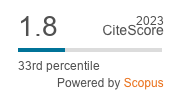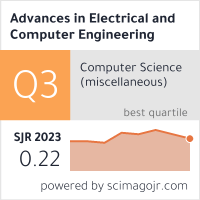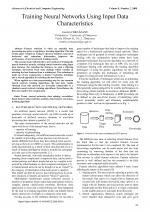| 2/2008 - 12 |
Training Neural Networks Using Input Data CharacteristicsCERNAZANU, C. |
| View the paper record and citations in |
| Click to see author's profile in |
| Download PDF |
Author keywords
neural networks, data mining, correlation-based feature subset selection method, data features extraction, training algorithm
References keywords
neural(8), networks(7), data(7), selection(6), learning(6), mining(5), machine(5), ijcnn(4), feature(4)
Blue keywords are present in both the references section and the paper title.
About this article
Date of Publication: 2008-06-02
Volume 8, Issue 2, Year 2008, On page(s): 65 - 70
ISSN: 1582-7445, e-ISSN: 1844-7600
Digital Object Identifier: 10.4316/AECE.2008.02012
Web of Science Accession Number: 000264815000012
SCOPUS ID: 77955635511
Abstract
Feature selection is often an essential data processing step prior to applying a learning algorithm. The aim of this paper consists in trying to discover whether removal of irrelevant and redundant information improves the performance of neural network training results. The present study will describe a new method of training the neural networks, namely, training neural networks using input data features. For selecting the features, we used a filtering technique (borrowed from data mining) which consists in selecting the best features from a training set. The technique is made up of two components: a feature evaluation technique and a search algorithm for selecting the best features. When applied as a data preprocessing step for one common neural network training algorithms, the best data results obtained from this network are favorably comparable to a classical neural network training algorithms. Nevertheless, the first one requires less computation. |
| References | | | Cited By |
Web of Science® Times Cited: 6 [View]
View record in Web of Science® [View]
View Related Records® [View]
Updated 2 days, 13 hours ago
SCOPUS® Times Cited: 7
View record in SCOPUS® [Free preview]
View citations in SCOPUS® [Free preview]
[1] Automatic and Parallel Optimized Learning for Neural Networks performing MIMO Applications, FULGINEI, F. R., LAUDANI, A., SALVINI, A., PARODI, M., Advances in Electrical and Computer Engineering, ISSN 1582-7445, Issue 1, Volume 13, 2013.
Digital Object Identifier: 10.4316/AECE.2013.01001 [CrossRef] [Full text]
[2] Enhancement of microgrid dynamic responses under fault conditions using artificial neural network for fast changes of photovoltaic radiation and FLC for wind turbine, Rezvani, Alireza, Izadbakhsh, Maziar, Gandomkar, Majid, Energy Systems, ISSN 1868-3967, Issue 4, Volume 6, 2015.
Digital Object Identifier: 10.1007/s12667-015-0156-6 [CrossRef]
[3] A novel sensorless field oriented controller for Permanent Magnet Synchronous Motors, Aygun, Hilmi, Gokdag, Mustafa, Aktas, Mustafa, Cernat, Mihai, 2014 IEEE 23rd International Symposium on Industrial Electronics (ISIE), ISBN 978-1-4799-2399-1, 2014.
Digital Object Identifier: 10.1109/ISIE.2014.6864700 [CrossRef]
Disclaimer: All information displayed above was retrieved by using remote connections to respective databases. For the best user experience, we update all data by using background processes, and use caches in order to reduce the load on the servers we retrieve the information from. As we have no control on the availability of the database servers and sometimes the Internet connectivity may be affected, we do not guarantee the information is correct or complete. For the most accurate data, please always consult the database sites directly. Some external links require authentication or an institutional subscription.
Web of Science® is a registered trademark of Clarivate Analytics, Scopus® is a registered trademark of Elsevier B.V., other product names, company names, brand names, trademarks and logos are the property of their respective owners.
Faculty of Electrical Engineering and Computer Science
Stefan cel Mare University of Suceava, Romania
All rights reserved: Advances in Electrical and Computer Engineering is a registered trademark of the Stefan cel Mare University of Suceava. No part of this publication may be reproduced, stored in a retrieval system, photocopied, recorded or archived, without the written permission from the Editor. When authors submit their papers for publication, they agree that the copyright for their article be transferred to the Faculty of Electrical Engineering and Computer Science, Stefan cel Mare University of Suceava, Romania, if and only if the articles are accepted for publication. The copyright covers the exclusive rights to reproduce and distribute the article, including reprints and translations.
Permission for other use: The copyright owner's consent does not extend to copying for general distribution, for promotion, for creating new works, or for resale. Specific written permission must be obtained from the Editor for such copying. Direct linking to files hosted on this website is strictly prohibited.
Disclaimer: Whilst every effort is made by the publishers and editorial board to see that no inaccurate or misleading data, opinions or statements appear in this journal, they wish to make it clear that all information and opinions formulated in the articles, as well as linguistic accuracy, are the sole responsibility of the author.





